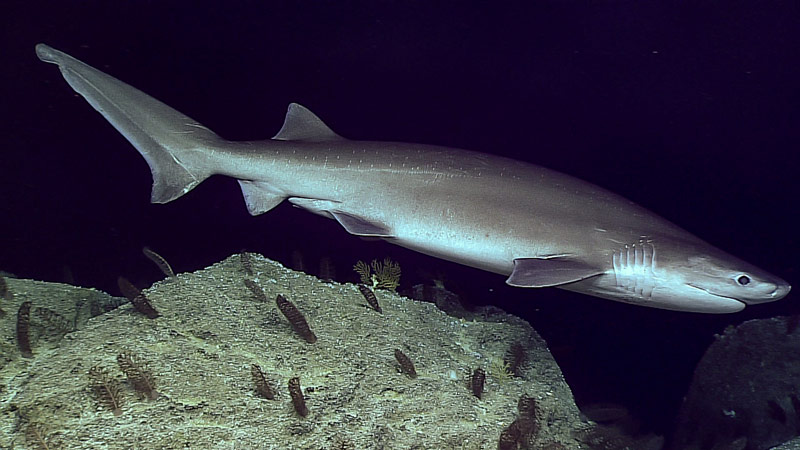
A large sixgill shark checks out D2. Image courtesy of the NOAA Office of Ocean Exploration and Research, Deepwater Wonders of Wake. Download larger version (jpg, 1.2 MB).

A large sixgill shark checks out D2. Image courtesy of the NOAA Office of Ocean Exploration and Research, Deepwater Wonders of Wake. Download larger version (jpg, 1.2 MB).
Dive 11: Around the Next Corner
Dive 11 was the second of two shallower dives during the expedition that targeted the precious coral resources around Wake Island. Scientists did find the commercially valuable gold coral, Kulamanamana sp., as well as thousands of rock pens and numerous species of fish, including a large sixgill shark. Video courtesy of the NOAA Office of Ocean Exploration and Research, Deepwater Wonders of Wake. Download larger version (mp4, 74.3 MB).
This was the second of two shallower dives targeting the precious coral resources around Wake Island. The first was on the northwest end of the island while today's dive was southeast of the island. The remotely operated vehicles (ROVs) reached the bottom around 21:11UTC at a depth of 640 meters. The dive ran along the top edge of what appeared to be a large slump or broken terrace wall on the slope of the island. This feature turned out to be a significant carbonate rock formation that had clearly undergone weathering and dissolution, at or above sea level. Subsequently, the present-day atoll near the surface generated and draped the ancient carbonate reef in a layer of coral sand. The location of this feature was just over a half mile from the eastern shore of Wake Atoll and one of the shallowest areas at that distance from the atoll. Consequently, this location helped to characterize precious corals and mid-water fish in the monument.
The terrain during this dive was dominated by carbonate deposits, sourced from the coral reef built on top of this atoll. The fauna on the carbonate varied depending on the nature of the substrate. Animals observed on sediment included fishes, sea pens, and an echiuran spoon worm. Animals found on the scattered boulders on the sediment included anemones, black corals, bamboo corals, crustaceans (shrimp and crabs), and echinoderms. When the ROV reached the dropoff, a large number of corals and other animals appeared, most notable of which were numerous precious gold coral colonies and thousands of rock pens. There were also numerous species of fish, including a large sixgill shark.